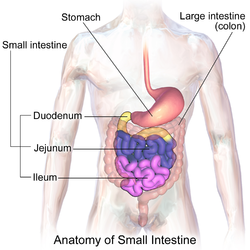Intestine, small
| Small Intestine | |
|---|---|

Diagram showing the small intestine and surrounding structures
|
|
| Details | |
| Artery | Superior mesenteric artery |
| Vein | Hepatic portal vein |
| Nerve | Celiac ganglia, vagus |
| Lymph | Intestinal lymph trunk |
| Identifiers | |
| Latin | Intestinum tenue |
| MeSH | A03.556.124.684 |
| Code | 4453467 |
| Dorlands /Elsevier |
Small intestine r |
| TA | A05.6.01.001 |
| FMA | 7200 |
|
Anatomical terminology
[]
|
|
The small intestine or small bowel is the part of the gastrointestinal tract between the stomach and the large intestine, and is where most of the end absorption of food takes place. The small intestine has three distinct regions – the duodenum, jejunum, and ileum. The duodenum receives bile and pancreatic juice through the pancreatic duct, controlled by the sphincter of Oddi. The primary function of the small intestine is the absorption of nutrients and minerals from food.
The length of the small intestine can vary greatly, from as short as 2.75 m (9.0 ft) to as long as 10.49 m (34.4 ft). The average length in a living person is 3m-5m. The length depends both on how tall the person is and how the length is measured. Taller people generally have a longer small intestine and measurements are generally longer after death and when the bowel is empty.
It is approximately 2.5–3 cm (1 inch) in diameter. On abdominal X-rays, the small intestine is considered to be abnormally dilated when the diameter exceeds 3cm. On CT scans, a diameter of over 2.5 cm is considered abnormally dilated. The surface area of the human small intestinal mucosa, due to enlargement caused by folds, villi and microvilli, averages 30 square meters.
The small intestine is divided into three structural parts.
The jejunum and ileum are suspended in the abdominal cavity by mesentery. The mesentery is part of the peritoneum. Arteries, veins, lymph vessels and nerves travel within the mesentery.
The small intestine receives a blood supply from the coeliac trunk and the superior mesenteric artery. These are both branches of the aorta. The duodenum receives blood from the coeliac trunk via the superior pancreaticoduodenal artery and from the superior mesenteric artery via the inferior pancreaticoduodenal artery. These two arteries both have anterior and posterior branches that meet in the midline and anastomose. The jejunum and ileum receive blood from the superior mesenteric artery. Branches of the superior mesenteric artery form a series of arches within the mesentery known as arterial arcades, which may be several layers deep. Straight blood vessels known as vasa recta travel from the arcades closest to the ileum and jejunum to the organs themselves.
...
Wikipedia
